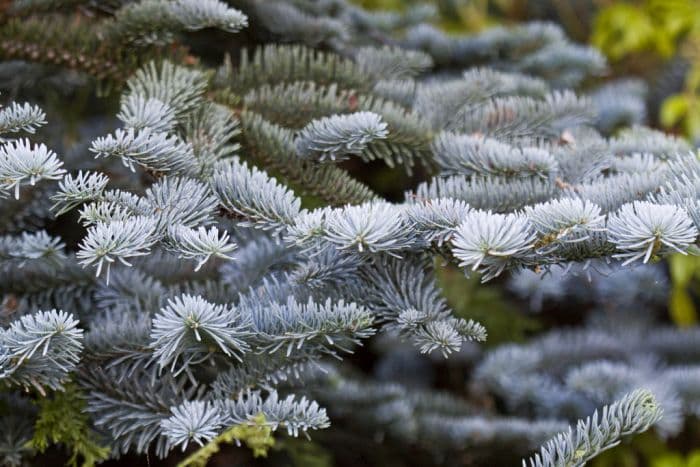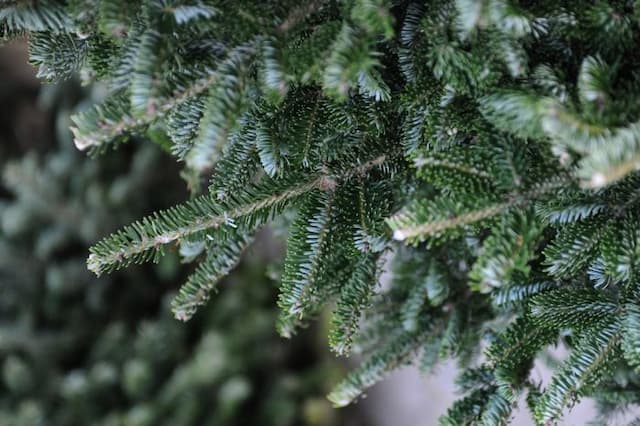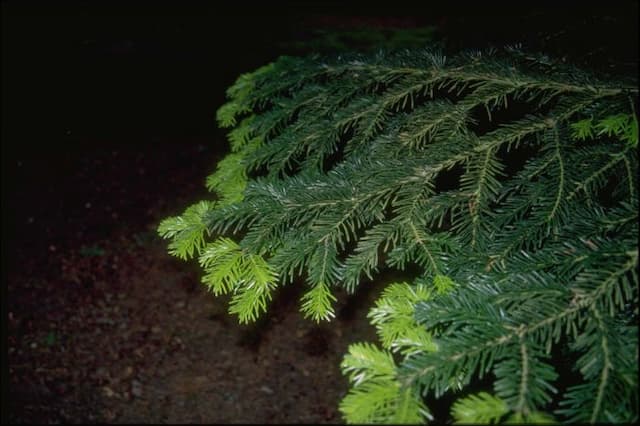Noble Fir Abies procera (Glauca Group) 'Glauca Prostrata'

ABOUT
The noble fir 'Glauca Prostrata', as it is commonly known, features striking blue-green needles that are soft to the touch and densely packed on its branches. Its needles display a unique, curved appearance that adds to its overall visual interest. The plant is characterized by a low-growing, sprawling form that tends to spread out horizontally rather than growing upwards, giving it a distinctive, ground-hugging silhouette. The branches grow in a radial pattern from the center of the plant, creating a symmetrical and uniform look that is visually pleasing. The foliage of the noble fir 'Glauca Prostrata' often takes on a silver-blue hue that can add a shimmering, frosty look to the landscape, making it a desirable choice for gardeners looking to create a serene and elegant environment.
About this plant
 Names
NamesFamily
Pinaceae
Synonyms
Blue Noble Fir, Prostrate Noble Fir, Dwarf Blue Noble Fir
Common names
Abies procera 'Glauca Prostrata'.
 Toxicity
ToxicityTo humans
Noble fir is not commonly known to be toxic to humans. While ingestion of plant parts is not recommended and can cause gastrointestinal discomfort or irritation, it is not typically associated with severe poisoning or life-threatening symptoms when consumed in small quantities.
To pets
Noble fir is generally considered non-toxic to pets. However, if pets ingest parts of the plant, they may experience mild gastrointestinal upset, such as vomiting or diarrhea. These symptoms are usually not severe, but monitoring your pet and consulting with a veterinarian if they display signs of distress is advisable.
 Characteristics
CharacteristicsLife cycle
Perennials
Foliage type
Evergreen
Color of leaves
Blue-green
Height
1 foot (0.3 meters)
Spread
6 feet (1.8 meters)
Plant type
Tree
Hardiness zones
4
Native area
North America
Benefits
 General Benefits
General Benefits- Ornamental appeal: 'Glauca Prostrata' offers aesthetic value with its distinctive silvery-blue foliage and unique prostrate growth habit, making it a striking addition to landscapes.
- Low maintenance: This cultivar is known to require minimal care once established, making it suitable for gardeners of all skill levels.
- Drought tolerance: Once established, it can withstand periods of dryness, reducing the need for frequent watering.
- Cold hardiness: It is well adapted to cold climates, capable of surviving freezing temperatures and making it suitable for gardens in colder regions.
- Wildlife habitat: The plant provides shelter and nesting sites for birds, contributing to biodiversity in the garden.
- Soil erosion control: The spreading habit of 'Glauca Prostrata' helps to stabilize the soil and prevent erosion on slopes and banks.
- Year-round interest: With its evergreen foliage, it maintains visual interest in the garden throughout all seasons.
- Windbreak: It can be used in landscaping to create a windbreak, protecting more sensitive plants and garden areas from strong winds.
- Privacy screen: Due to its foliage density, 'Glauca Prostrata' can be effectively utilized as a privacy screen or hedge.
 Medical Properties
Medical PropertiesThis plant is not used for medical purposes.
 Air-purifying Qualities
Air-purifying QualitiesThis plant is not specifically known for air purifying qualities.
 Other Uses
Other Uses- Noble fir 'Glauca Prostrata' branches are sometimes used for making wreaths and garlands during the holiday season due to their silvery-blue foliage and pleasing aroma.
- The wood of the noble fir 'Glauca Prostrata' can be used in woodworking projects, particularly for crafting small decorative items or ornaments, thanks to its fine-grain and workability.
- The resin from noble fir 'Glauca Prostrata' can sometimes be collected and used as a natural adhesive or sealant in traditional crafts.
- Dried noble fir 'Glauca Prostrata' needles can be used as a natural stuffing material for aromatic sachets, which can impart their fragrance to linens and clothing.
- When dried and crumbled, the noble fir 'Glauca Prostrata' foliage can be used as a component in potpourri mixes, contributing a fresh, forest-like scent to the blend.
- The noble fir 'Glauca Prostrata' is sometimes used as a specimen tree in bonsai cultivation, with enthusiasts valuing its slow growth rate and ability to be shaped.
- The needles of the noble fir 'Glauca Prostrata' can also be used as a natural mulch for garden beds, providing a barrier against weeds and helping to retain soil moisture.
- Landscape artists may use the noble fir 'Glauca Prostrata' to create unique garden topiaries, as its growth habit can be trained into artistic shapes.
- Branches from the noble fir 'Glauca Prostrata' can be used in floral arrangements, particularly for creating a winter-themed aesthetic, due to their long-lasting nature.
- The noble fir 'Glauca Prostrata' can serve as a natural habitat in garden settings, offering shelter and nesting opportunities for birds and other wildlife.
Interesting Facts
 Feng Shui
Feng ShuiThe Noble Fir is not used in Feng Shui practice.
 Zodiac Sign Compitability
Zodiac Sign CompitabilityThe Noble Fir is not used in astrology practice.
 Plant Symbolism
Plant Symbolism- Longevity and Endurance: The Noble Fir, as a long-lived evergreen, symbolizes the ability to withstand the test of time and endure harsh conditions.
- Resilience: Its adaptability to its environment conveys resilience and the capacity to rise above challenges.
- Purity and Cleansing: The evergreen foliage and forest fragrance are often associated with cleansing, representing a fresh start or purification.
- Festivity and Celebration: As a popular Christmas tree, the Noble Fir is emblematic of the holiday season, joy, and the spirit of giving.
- Majesty and Nobility: Its grand stature and the name 'Noble' suggest a sense of dignity, majesty, and elevated spirit, making it a symbol of nobility.
 Water
WaterFor Noble Fir 'Glauca Prostrata', it is important to maintain consistent moisture without overwatering. Water the plant deeply about once a week, allowing the soil to dry slightly between waterings. During hot, dry periods, you may need to water twice a week. Each watering should provide enough moisture to soak the soil to a depth of about 6 inches, roughly equivalent to 1 to 2 gallons depending on the size of the plant and the soil type. Cut back on watering during the winter months when the plant is dormant, as it requires less moisture during this time.
 Light
LightNoble Fir 'Glauca Prostrata' thrives best in full sun to partial shade. It should be planted in a location where it will receive at least six hours of direct sunlight each day for optimal growth and health. However, in regions with particularly intense sunlight, some afternoon shade can be beneficial to prevent scorching of the needles.
 Temperature
TemperatureThe Noble Fir 'Glauca Prostrata' can withstand a wide range of temperatures but prefers cooler climates characteristic of its natural mountainous habitats. It is hardy and can survive temperatures as low as -30°F and as high as 80°F, but the ideal temperature range is between 40°F and 70°F. This plant is not well-suited to extended periods of heat, especially in combination with high humidity.
 Pruning
PruningPruning of Noble Fir 'Glauca Prostrata' is generally minimal and should be aimed at maintaining its natural form, removing damaged or diseased branches, and promoting dense growth. The best time to prune is in late winter or early spring before new growth starts. This plant does not require regular shaping; prune only as necessary to maintain a healthy structure, ideally not more than once per year.
 Cleaning
CleaningAs needed
 Soil
SoilNoble Fir 'Glauca Prostrata' thrives best in a well-draining soil mixture with a slightly acidic to neutral pH, typically between 5.5 and 7.0. The ideal soil mix can be created by combining one part peat with one part loam and one part sand or perlite, which ensures proper aeration and drainage essential for the plant's root system.
 Repotting
RepottingNoble Fir 'Glauca Prostrata' does not require frequent repotting as it is a slow-growing plant. It should be repotted every 3 to 4 years to refresh the soil and to accommodate the gradually increasing root system. Repotting should be done cautiously to avoid root damage.
 Humidity & Misting
Humidity & MistingNoble Fir 'Glauca Prostrata' prefers moderate humidity levels, typical of its natural woodland habitat. However, it is quite adaptable and can tolerate the humidity levels commonly found in most outdoor garden environments. There is no specific humidity requirement, but avoiding excessively dry or damp conditions is beneficial for the plant.
 Suitable locations
Suitable locationsIndoor
Provide ample light & occasional watering.
Outdoor
Plant in full sun & well-draining soil.
Hardiness zone
4-8 USDA
 Life cycle
Life cycleThe life cycle of Noble Fir 'Glauca Prostrata' starts with seed germination, where conditions like moist soil and proper temperature allow the seed to sprout and develop into a seedling. The seedling stage involves initial growth where the plant develops its root system and foliage, and depending on conditions, this phase can last for several years. As it matures, the Noble Fir 'Glauca Prostrata' enters a juvenile phase, where it grows more rapidly and begins to take on the characteristic prostrate or low-growing form. Proceeding to the adult phase, the plant reaches reproductive maturity, developing cones that will produce seeds; in conifers, this occurs after reaching a certain size rather than age. The plant maintains its mature form for many years, capable of surviving and thriving under optimal conditions such as well-drained soil with full sun to partial shade exposure. Finally, the Noble Fir 'Glauca Prostrata' enters a phase of senescence, where growth slows and the plant may become more susceptible to environmental stresses, pests, and diseases, eventually leading to its death.
 Propogation
PropogationPropogation time
Spring to early summer
The Noble Fir, particularly the 'Glauca Prostrata' variety, is commonly propagated through grafting. Grafting is usually done in late winter or early spring before new growth begins. This method involves taking a short piece of a stem with a bud from the 'Glauca Prostrata' and joining it to the stock plant, ensuring that the vascular tissues match up so that they can grow together. The grafted joint is then taped or bound until the graft has taken, typically a few weeks to a few months. This technique harnesses the desirable qualities of 'Glauca Prostrata' and ensures that the offspring are true to type, preserving the distinct blue-gray foliage and prostrate growth habit of this cultivar.








